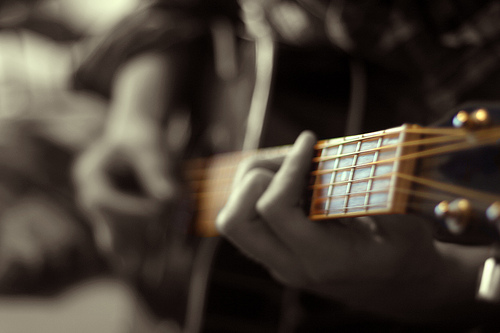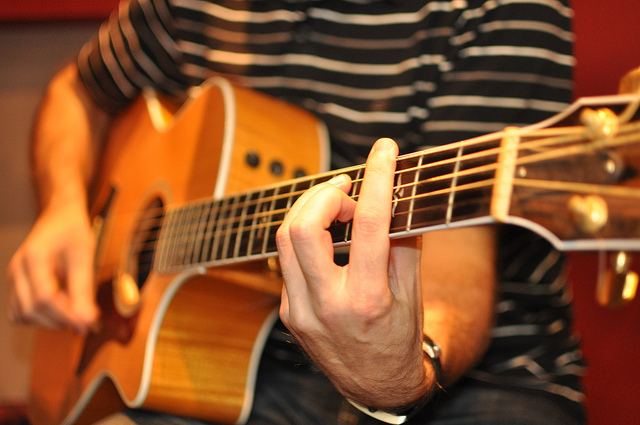
One of the trickiest parts of playing the guitar is playing notes in the same fret but on different strings. As with most guitar issues, there are different ways to overcome this problem.
Most often people just practice hard to use a different finger for each note, but you could take the finger rolling approach to solving this problem as well. It is definitely worth trying out – if it’s not your thing, you can always learn something different.

Finger rolling is a great technique to learn. Image courtesy of simon_music, CC BY 2.0, via Flickr.
Here are some exercises to help you master this finger rolling technique.
Practice, Then Practice Some More
First, you should get the hang of what finger rolling is all about before you move on to more demanding exercises. It’ll take some time, so just keep practicing until you nail the technique!
Start by playing the notes G and C on the 5th fret. You’ll find the note G on 4th string and the note C on the 3rd string.
Position the tip of your finger on the note G, meaning on the 4th string and 5th fret. As you’ve played the note, roll your finger to note C, which is 3rd string and 5th fret.
While you roll part of the finger to note C, you’ll still keep your finger in contact with the 4th string as well to mute it.
Play the note C, and roll your finger back to note G. Again, the bottom part of your finger needs to mute the 3rd string now.
You can even practice the finger movement without the guitar. Place your fingertip on a flat surface and slowly flatten the finger. Try keeping the tip slightly in the air, while pressing down with the middle part of the finger.
It might sound complicated and it is – just stay patient. The most important, and the most difficult, part of the technique is the muting part, so pay a lot of attention to it.
Mix the notes and the frets a bit to add more depth to your finger rolling.
Add the Minor Pentatonic Scale
Once you’ve made the most of the above practice and developed your finger rolling a bit, you can enhance your technique by practicing with the minor pentatonic scale.
Of course, you don’t necessarily need to roll the notes, but the practice will give you more of a challenge.
Here’s one tab you can add to your practice routine. It uses the basic finger position in the A Minor Pentatonic:
———————————— |——————————————– |
———————————— |——————————————– |
———————————— |—————————–5——–8— |
———————–5——-7– |——–5——–7—-5——–7——— |
——5——7—5——-7——- |—5——–7—————————– |
–5—– 8————————- |——————————————– |
You can look at other scales as well and even play them in reverse order. The main thing is to find these note connections and practice them until you get a better hang of the finger rolling technique.
As mentioned above, finger rolling technique is a nice addition to your practice, but it isn’t the only method of dealing with these notes. Yet, it is still worth checking it out – it might feel a lot easier to master these notes with this technique.
Quite a big selection of songs use this technique and you’ll quickly discover them as your skills progress. For instance, the Spanish Romance, or Romanza, uses the rolling technique.
Just remember to practice a lot until you feel comfortable with the technique!
Are you a guitarist? Check out our full range of online guitar lessonsAre you a saxophonist? Check out our full range of online saxophone lessons
Subscribe to Pro Music Tutor from as little as £7.99 per month
Related Posts
-
The Benefits of Online Music Education
Learning music has never been easier, since the internet and modern technological advancements have opened the doors to countless possibilities, expanding the subjects people can choose from and how the lessons are taught. Now, people can study a whole host of music-related topics; from learning to play guitar or DJing, to understanding the inner workings […]
View All >> -
Essential Jazz Guitar Scales that are Easy to Learn
Improvising in jazz requires the ability to play in different keys over different chords. Results certainly do not come overnight, but with diligent practice, you would be surprised by what you can achieve. Many people ask me about what scales I use as if they were some big secret. While knowing your scales is very […]
View All >>
Latest Blog Entries
-
The Benefits of Online Music Education
Learning music has never been easier, since the internet and modern technological advancements have opened the doors to countless possibilities, expanding the subjects people can choose from and how the lessons are taught. Now, people can study a whole host of music-related topics; from learning to play guitar or DJing, to understanding the inner workings […]
View All >> -
Essential Jazz Guitar Scales that are Easy to Learn
Improvising in jazz requires the ability to play in different keys over different chords. Results certainly do not come overnight, but with diligent practice, you would be surprised by what you can achieve. Many people ask me about what scales I use as if they were some big secret. While knowing your scales is very […]
View All >>
Blog Categories
- Categories
- Guitar Tips (93)
- History (36)
- How-To (38)
- Interviews (3)
- Music Industry (121)
- Prolinks Guitar (2)
- Prolinks Lessons (3)
- Prolinks Tutor's Profile (1)
- Saxophone Tips (40)
- Uncategorized (6)
Tags
Archive
- November 2018 (1)
- February 2018 (1)
- December 2017 (1)
- November 2017 (1)
- October 2017 (1)
- July 2017 (4)
- May 2017 (2)
- April 2017 (1)
- August 2016 (2)
- July 2016 (1)
- June 2016 (2)
- May 2016 (3)

